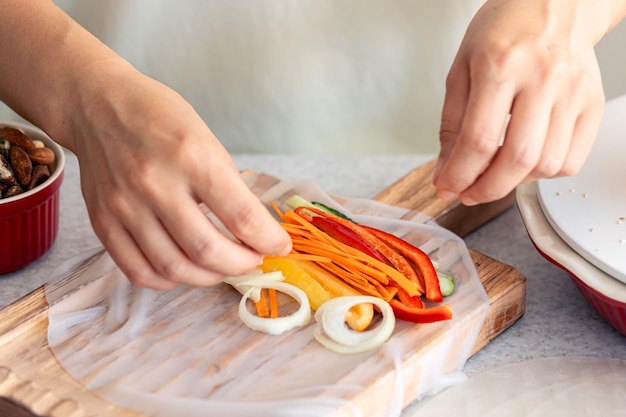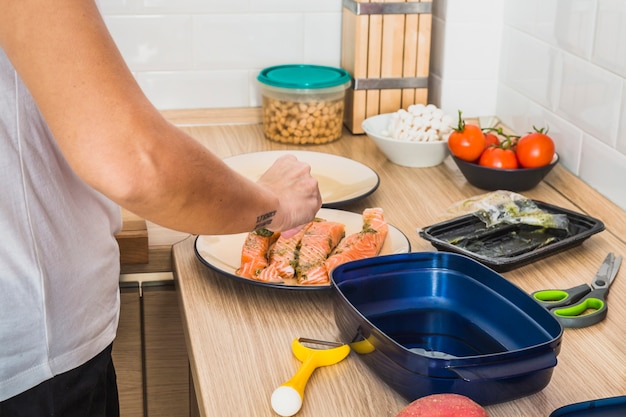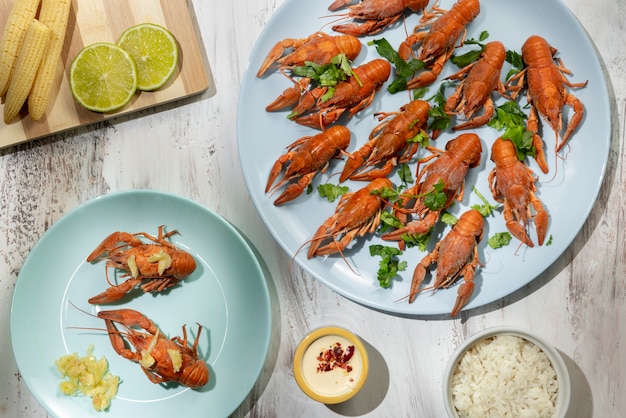Shrimp! Just the word makes my mouth water. It's a wonderfully versatile ingredient, perfect for a quick weeknight meal or a fancy dinner party. But, like anything, cooking shrimp can feel a little daunting if you're not sure where to start. Fear not, my fellow foodie friends! This guide is your ultimate resource for all things shrimp, from selecting the perfect crustacean to whipping up dishes that will have your taste buds singing.
Part 1: A Deep Dive into the Wonderful World of Shrimp

Understanding the Varieties
Let's start by getting to know our shrimp. There's a whole world of varieties out there, each with its own unique characteristics. For instance, I'm a big fan of whiteleg shrimp. They're plump, have a delicate sweetness, and are a real crowd-pleaser. But don't be afraid to try something new! You might discover a hidden gem. From the delicate flavour of the tiny cocktail shrimp to the firm texture of jumbo prawns, there's a perfect shrimp for every occasion.
Freshness: The Secret Ingredient
I know it's tempting to grab a bag of frozen shrimp when you're short on time, but trust me, fresh shrimp is in a league of its own. The difference in flavour is truly remarkable. Look for shrimp with a firm texture, a shiny, translucent shell, and a pleasant, slightly sweet smell. Avoid any that look dry, discoloured, or have an unpleasant odor.
Size Matters: Choosing the Right Size
When it comes to shrimp, size matters! Small shrimp, like those you find in a bag labelled "cocktail shrimp," are perfect for salads or appetizers. They're delicate and add a lovely pop of flavour. Medium shrimp are ideal for grilling or sauteing. They're versatile and cook quickly, making them perfect for a busy weeknight. Large shrimp are best for baking or grilling on skewers. Their firm texture holds up well to these cooking methods.
Part 2: Prepping Your Shrimp: The Basics

The Delicate Art of Deveining
You've got your beautiful, fresh shrimp. Now it's time to prep them! The first step is often deveining, which is removing the dark vein running along the back of the shrimp. This vein, known as the intestinal tract, can sometimes have a slightly gritty texture, and many people prefer to remove it for a cleaner taste and appearance.
Deveining is pretty straightforward. Use a sharp knife to make a shallow cut down the back of the shrimp, then gently pull out the vein with a toothpick or the tip of a knife. Don't worry if you're a bit hesitant at first, it's really not that complicated!
The Peel or Don't Peel Dilemma
Another decision you'll need to make is whether to peel your shrimp. It's a matter of personal preference and what you're cooking. For some dishes, like stir-fries or salads, the shells can add texture and flavour, and you can leave them on. But, if you prefer a more elegant presentation or simply don't want to bother with peeling, then go for it!
To peel shrimp, gently twist the head off, then peel the shell off from the tail. It's as simple as that!
Part 3: Elevate Your Shrimp with Delicious Marinades

Unlocking Flavour with Marinades
A good marinade can truly transform your shrimp into a culinary masterpiece. Think of it as adding an extra layer of flavour and tenderness. There's no right or wrong way to create a marinade, so feel free to get creative! But, there are some ingredients that I've found really work wonders.
My Go-To shrimp marinade: Simple Yet Delicious
My personal favourite is a simple blend of olive oil, lemon juice, garlic, and fresh herbs. I love using fresh herbs like parsley, dill, or oregano, but dried herbs will also do the trick. Add a pinch of salt and pepper, and let the shrimp soak in the marinade for at least 30 minutes before cooking.
Adding a Kick with Spice
For a bit more zing, you can add a splash of chili flakes, soy sauce, or ginger to your marinade. Just remember to adjust the seasoning to your liking. The possibilities are endless!
Part 4: cooking techniques for Shrimp: Explore the Options
Pan-Frying: Quick and Easy
Pan-frying is my go-to method for cooking shrimp. It's fast, easy, and you get perfectly cooked shrimp every time. Simply heat some olive oil in a pan over medium heat, then add the shrimp. Cook for about 2-3 minutes per side, until they are pink and opaque and start to curl.
Grilling: Summertime Delight
There's something so satisfying about grilling shrimp on a warm summer day. Thread the shrimp onto skewers, making sure they're spaced out so they cook evenly. Grill them over medium heat for 2-3 minutes per side. For a smoky flavour, try grilling them over charcoal.
Baking: Perfect for a Crowd
Baking is a great option if you're cooking for a crowd. It's a hands-off method, so you can get other things done while your shrimp cooks. Toss the shrimp in your favourite marinade, then spread them out on a baking sheet. Bake in a preheated oven at 400 degrees Fahrenheit for 10-12 minutes, or until they are cooked through.
Boiling: A Simple Approach
Boiling is a simple method that's perfect for making shrimp stock or adding shrimp to soups and stews. Bring a pot of salted water to a boil, then add the shrimp. Cook for 2-3 minutes, or until they are pink and opaque.
Part 5: shrimp recipes: Inspiration for Every Occasion
shrimp scampi: A Classic Italian Delight
Shrimp scampi is a classic Italian dish that's both delicious and easy to make. It's made with shrimp, garlic, white wine, butter, and lemon juice, creating a simple yet sophisticated dish. You can find a simple recipe online, or check out my recipe in the recipe section at the end of this article.
shrimp tacos: A Mexican Favourite
Shrimp tacos are a fun and festive dish that's perfect for a casual gathering. Simply cook some shrimp in your favourite marinade, then serve them in warm tortillas with your favourite toppings. I love adding salsa, avocado, and a dollop of sour cream. For a twist on a classic, try my recipe for a delicious shrimp taco that's sure to impress.
Spicy shrimp pasta: A comfort food Classic
Shrimp pasta is a true comfort food classic. There are endless variations on this dish, but I particularly love a spicy shrimp pasta with garlic, chili flakes, and cherry tomatoes. You can find a simple recipe for this dish in the recipe section at the end of this article.
Shrimp Curry: An Indian Delight
Shrimp curry is a flavourful and aromatic dish that's sure to impress. It's made with shrimp, coconut milk, curry powder, and other spices. You can find a simple recipe online, or check out my recipe for a delicious shrimp curry that's sure to be a hit.
Part 6: Serving Shrimp with Style
Presentation Matters: Make it a Visual Feast
Okay, so you've cooked up a delicious batch of shrimp. Now it's time to put them on display! Don't underestimate the power of a beautiful presentation. It can really make your meal feel special and elevate the dining experience.
Think Outside the Box: Get Creative with Your Presentation
Don't be afraid to get creative with your presentation. You can serve shrimp on a bed of rice, quinoa, or couscous. Or, you can get fancy and serve them on a platter with a variety of dipping sauces, like cocktail sauce, mango salsa, or aioli.
Garnish with Style: Adding Finishing Touches
Don't forget the garnishes! A sprinkle of chopped fresh herbs, a squeeze of lemon, or a drizzle of olive oil can make your shrimp look even more appealing and add a burst of flavour.
Part 7: shrimp storage and Leftovers
Storing Shrimp: Keeping Your Shrimp Fresh
Once you've got your fresh shrimp, it's important to store them properly to keep them fresh. Fresh shrimp should be stored in the refrigerator for no more than 1-2 days. Wrap them in plastic wrap or store them in a sealed container. You can also freeze shrimp for up to 3 months. Just make sure to freeze them in a freezer-safe bag or container.
reheating shrimp: Gentle is Best
When it comes to reheating shrimp, less is more. The best way to reheat shrimp is to gently warm them in a pan with a little bit of butter or olive oil. Avoid reheating them in the microwave, as this can make them tough and rubbery.
leftover shrimp: Delicious Possibilities
If you have leftover shrimp, don't let it go to waste! You can use it in salads, sandwiches, or soups. You can also freeze leftover shrimp for later use.
Part 8: shrimp faqs: Common Questions Answered
Q: How do I know if shrimp is cooked?
A: Shrimp is cooked when it turns pink and opaque. You'll also notice that the shrimp starts to curl up when it's cooked through.
Q: Can I eat the shrimp head?
A: You can eat the shrimp head, but it's not for everyone! Some people find it a bit chewy or crunchy. If you're feeling adventurous, you can try it. But, it's perfectly fine to remove the head before cooking.
Q: What's the best way to season shrimp?
A: There's no one right answer here. It really depends on your taste and the dish you're making. A good starting point is to season shrimp with salt, pepper, garlic, and herbs. You can also add a little bit of lemon juice or chili flakes for more flavour.
Q: How do I make shrimp stock?
A: Shrimp stock is a great way to add a delicious seafood flavour to your dishes. To make shrimp stock, simply simmer shrimp shells with water, vegetables, and spices for at least 30 minutes. Then, strain the stock and use it in soups, stews, or sauces.
Q: What's the best way to clean shrimp?
A: The best way to clean shrimp is to remove the vein, or "intestine," running down the back of the shrimp. You can do this by making a shallow cut down the back of the shrimp, then gently pulling out the vein with a toothpick or the tip of a knife.
Part 9: Shrimp Recipe Collection: Delicious Dishes to Try
Shrimp Scampi
Ingredients:
1 pound large shrimp, peeled and deveined
4 tablespoons butter
4 cloves garlic, minced
1/2 cup dry white wine
1/4 cup lemon juice
1/4 cup chopped fresh parsley
Salt and pepper to taste
Pasta, for serving (optional)
Instructions:
1. Melt the butter in a large skillet over medium heat.
2. Add the garlic and cook for about 1 minute, until fragrant.
3. Add the shrimp and cook for about 2-3 minutes per side, until they are pink and opaque.
4. Add the white wine and lemon juice, and bring to a simmer.
5. Cook for about 1 minute, until the sauce has thickened slightly.
6. Stir in the parsley, and season with salt and pepper to taste.
7. Serve over pasta, if desired.
Shrimp Tacos
Ingredients:
1 pound shrimp, peeled and deveined
1 tablespoon olive oil
1/2 teaspoon cumin
1/4 teaspoon chili powder
1/4 teaspoon salt
1/4 teaspoon black pepper
1/2 cup chopped red onion
1/2 cup chopped cilantro
1/2 cup salsa
1/4 cup sour cream
Warm tortillas
Instructions:
1. Heat the olive oil in a large skillet over medium heat.
2. Add the shrimp, cumin, chili powder, salt, and pepper.
3. Cook for about 2-3 minutes per side, until the shrimp are pink and opaque.
4. In a bowl, combine the red onion, cilantro, salsa, and sour cream.
5. To assemble the tacos, warm the tortillas.
6. Fill the tortillas with the shrimp, and top with the salsa mixture.
Spicy Shrimp Pasta
Ingredients:
1 pound shrimp, peeled and deveined
1 tablespoon olive oil
1/2 teaspoon garlic powder
1/4 teaspoon red pepper flakes
1/4 teaspoon salt
1/4 teaspoon black pepper
1/2 cup chopped cherry tomatoes
1/2 cup chopped fresh basil
1/4 cup grated Parmesan cheese
1 pound pasta, cooked
Instructions:
1. Heat the olive oil in a large skillet over medium heat.
2. Add the shrimp, garlic powder, red pepper flakes, salt, and pepper.
3. Cook for about 2-3 minutes per side, until the shrimp are pink and opaque.
4. Add the cherry tomatoes and basil.
5. Cook for about 5 minutes, until the tomatoes are softened.
6. Add the cooked pasta to the skillet.
7. Toss to combine.
8. Top with the Parmesan cheese.
Part 10: Tips and Tricks for Shrimp Success
Quick Tips for Perfect Shrimp
Pat shrimp dry before cooking to help them cook evenly and develop a nice crust.
Don't overcrowd the pan when cooking shrimp. This will prevent them from cooking properly and steaming instead of browning.
If you're grilling shrimp, make sure to thread them onto skewers to prevent them from falling into the grill.
Serve shrimp with a variety of dipping sauces for a fun and interactive meal.
Troubleshooting: Addressing Common Issues
Shrimp is dry: If your shrimp is dry, it may be overcooked. Try cooking it for a shorter amount of time next time.
Shrimp is rubbery: If your shrimp is rubbery, it may be overcooked. Try cooking it for a shorter amount of time next time.
Shrimp is fishy: If your shrimp has a fishy smell, it may be spoiled. Do not eat it.
There you have it, a comprehensive guide to cooking shrimp! With a little bit of practice, you'll be whipping up delicious shrimp dishes in no time. Happy cooking!
Everyone is watching

Corn on the Cob: The Ultimate Guide to Perfectly Cooked Ears
Healthy MealsAh, corn on the cob. Just the name evokes images of sunny days, barbecues, and that sweet, juicy flavour that ...

Perfect Pork Roast Oven Cooking Time: A Guide to Delicious Results
Healthy MealsThere's something truly satisfying about a perfectly roasted pork. The aroma alone is enough to make your mout...

Ham Cooking Time: How Long to Bake, Smoke, or Boil a Delicious Ham
Healthy MealsAh, ham. It's a classic, isn't it? A real crowd-pleaser, especially around holidays. And when done right, it'...

Scallops: The Ultimate Guide to Perfect Cooking
Healthy MealsAh, scallops. Those delicate, sweet, and utterly delicious morsels of the sea. They hold a special place in my...

Spaghetti Squash: The Ultimate Guide to Cooking and Serving
Healthy MealsRemember that time you saw spaghetti squash at the supermarket, looking all bumpy and strange, and thought, "W...
